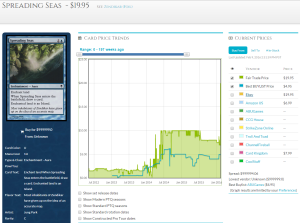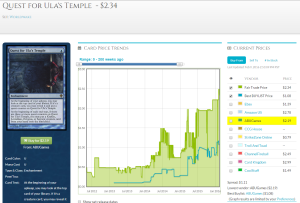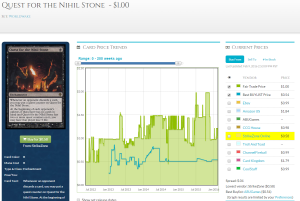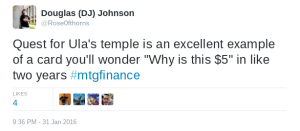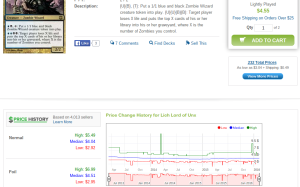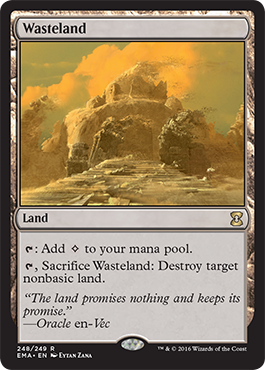I would be remiss if I didn’t address the fact that Eternal Masters was announced this week. This is going to be one of the most significant MTG Finance events of 2016 so we can’t pretend we won’t be affected, can we? Legacy as we know it is going to change as staples like Force of Will and Wasteland go down in price (We know this because these cards were announced) and cards like Underground Sea go up in price. And why not? Cards that aren’t safe from reprint could easily be in the set and their prices as volatile and unknown while Reserved List cards are safe from reprint and therefore subject to price increases based on increased confidence from buyers. We’re already seeing consequences of the announcement and at the time of writing this piece, it hasn’t even been 24 hours.

Underground Sea is STARTING at $300. Who knows what we’ll be paying in a few weeks? How could this happen? More importantly, are there decks that don’t need duals and other crazy Reserved List cards to work in Legacy?
Well, I don’t care about that last question. Let other nerds write articles about decks that don’t need Reserved List cards. We are interested in EDH cards and if the Reserved List overlaps with cards we want, we’d better get them sooner rather than later. I wrote about EDH/Eternal overlap last week and while I’d like to write about something entirely different this week, I’m not gonna. We should look at cards that overlap Legacy and EDH, but this time with respect to the Reserved List specifically because Legacy is about to change and we don’t want EDH to get left behind. Are there cards that see play in both formats that could go up? Probably. Let’s look.
This is a list of cards WotC has promised it won’t reprint. It is in their legal best interest to abide by the promise and a lot of us have money tied up in cards that would be hurt financially by a breaking of this promise. Put simply, this list is a way for us to have some confidence in our investments in older cards so we can avoid another situation like Chronicles where reprints pantsed prices on a lot of cards and undermined confidence in the rest. While some cards on this list are baffling (I’m looking at you, Sorrow’s Path) what we have is a good list to base future buys off of. A lot of the cards on this list aren’t EDH-playable, but the ones that are can be relied on to go up in value, steadily due to the fact that they can’t have their value hurt by a future reprint. There isn’t a huge sense of urgency on every card, though, so the impetus of this article is to identify the cards that could go up if interest in Legacy increases the way they expect it to with the advent of Eternal Masters.
The obvious first cards to discuss are Legacy Dual Lands.

These are all bound to go up. Force of Will will likely go down or stay the same in value but people who have Force of Will for the first time by virtue of picking up Eternal Masters packs will want to build Legacy deck(s) and they’ll need these. Not only that, speculators are already going after these, hard. Since a non-zero number of EDH players pack these, it’s worth watching. Grab the ones you need now because supplies are drying up.

Geyser is a great way to use X colorless mana, although players tend to use Blue Sun’s Zenith more, this is a card that could see a bump. Zenith tends to get Legacy play more as well, and three printings of this limit its upside farther.

At $7 for its cheapest printing can attest, this card is actual money. Used in a significant number of artifact-based decks like Sharuu, this also sees play in Tezzerator Legacy decks and has been creeping up steadily for a while. It’s always been a good pick, but its reserved list status can only help its upside.

Fringe EDH play and Fringe Legacy play combined could spell upside for a card that has held steady in price but could go up in a Tezz deck in the new Legacy, especially if someone figures out how to cut down on the number of expensive Underground Sea in the deck.

On the other hand, this is fringe EDH and mainstream Legacy, but those fringe EDH decks better get their copies while they can.

This is useful in decks like Zedruu and Legacy Enchantress both. At $300ish this is a high buy-in but I feel like soon $300 may seem like a bargain. I don’t know how much money there is to be made here, but I’d feel remiss if I ignored it.

This is part of an obscure combo that hasn’t seen much play lately, but this is a card that sees play in decks like The Mimeoplasm as well. There is upside here and with this card having already demonstrated the ability to be $5 and the copies being concentrated in the hands of dealers making a second spike easier, I think this could be a winner.

Nekusar decks as well as Hellbent decks want this little trinket which is too bad since Legacy has made this a $120 card already and threatens to take it even higher. This is a card you may want to eschew in EDH if you can since you don’t have that luxury in Legacy.

This gets more EDH play than you might expect and its current pricetag is on the low end of historical date, which I don’t expect to hold since Eldrazi Mimic has made this a much more attractive target. Stiflenought is a real deck and with 4 more ways to make this a savage 1-drop, this has real upside. This can be $40 again and you want to be holding when it gets there.

A long-time sideboard staple is making a splash in decks like Gaddock Teeg and other “Uh uh, you didn’t say the magic word” type decks in EDH as well. This is a card that we may see on creatures or other ways to avoid making a straight-up functional reprint that violated the Reserved List but it’s unlikely we see a card as perfect and perfectly-costed as this. This is at a historical high but that doesn’t mean it will never be higher.

This is a card that has demonstrated an ability to be $10+ and is super good at shutting down creature strategies. Its toughness means it’s relatively easy to remove and Abrupt Decay being everywhere doesn’t help and you still have to find a way to kill them with this card out there, but don’t be discouraged. This is a solid card and EDH wants it as well as Legacy. This could be $10 again and you will be glad you paid $3. When Merfolk and other beatface decks prevail rather than decks like Sneak and Show, this is a real card and Eldrazi cards showing their head in Legacy to an extent show that people may be swinging with creatures more in the future. Keep this in mind.

Speaking of Eldrazi in Legacy, this budget Workshops is a real mana generator and it is no slouch in EDH, either. Anything that generates this much mana is bound to turn heads and this card is creeping up on its own. Any nod it gets from Legacy will send it upward.

Aluren itself isn’t the limiting factor in the eponymous deck, it’s Imperial Recruiter that keeps this deck that can kill people with Lobber Crew if you want (I want) from being played more. This spiked before when Recruiter was announced as a Judge printing and while a dealer or two who had advanced knowledge acted on this and bought all of the Alurens out, this play is largely acknowledged as a huge failure and brought up a a cautionary tale regarding buyouts. The good news is that failed buyout concentrated copies of Aluren in the hands of dealers meaning the price will stay higher for longer if the card spikes again. If Imperial Recruiter ends up in Eternal Masters, and I don’t see why it wouldn’t, Aluren becomes a very affordable and fun deck to play and Aluren itself with its Reserved List status will only go up, possibly back to the $30 a few people thought they were going to get a few years ago.

When I bought a bunch of these at $10, I expected to make more money than I did. I didn’t lose money here but I wasn’t happy with how I did. I could do better.This card could do better. This card will likely do better if Show and Tell decks persist. Sneak Attack and/or Show and Tell being printed in EM could drive popularity up and this is a great board card in those matchups as well as a nasty card for enchantment EDH decks. All in all I like this card a lot, even at its current price.

This has always been a fine card and people wanting to jam this with Hedron Alignment in Legacy won’t make the price go down, that’s for sure. This does a lot of work in EDH and this price tag is at a historic low for the last few years. All signs pointing to this being a pretty tasty spec.
 Why did this card ever stop being $20? The deck is still fine, it lets you run out a very early Omnipotence, it makes cards like Conflux playable and it’s great in EDH. This can be $20 again and the current buy-in is pretty tasty for that contigency.
Why did this card ever stop being $20? The deck is still fine, it lets you run out a very early Omnipotence, it makes cards like Conflux playable and it’s great in EDH. This can be $20 again and the current buy-in is pretty tasty for that contigency.

If you want this for EDH, I think now is a good time to pick this up. Its price plateauing is predicated on Legacy demand staying the same. How long do you think that will last? This won’t be in Eternal Masters but will be in decks going forward. This is also an EDH staple and just does a ton of work. This price will be higher soon and if you buy now, you’ll be glad you did, I imagine.

This card demonstrated the ability to hit $100 and I think it can get there again, especially since the first spike concentrated copies in the hands of dealers meaning copies won’t come out of the woodwork to bring the price down. This taps for 2 mana, and 2 true colorless mana at that. Sounds good to me.

I wish I had been writing this column back in 2013 when they changed the Legend rule so I could have written an article about how Cradle and Mox Opal were getting better with the ability to play a second copy and sac the tapped copy giving you more mana on that turn. Legacy players got the message, then Elves took off in Legacy and even Vintage got in on the act, running Cradle in some shops builds since it’s not restricted in that format. This price isn’t going down as more people join Legacy, is it? EDH demand will keep the price high and this is a perfect crossover example.

I told you to buy this at $30, I don’t know what more I can do. Legacy Enchantress is a deck and will continue to be a deck. Add how good this is with the new Daxos and you have a crossover card that could give Gaea’s Cradle a run for its money. I mean, no it won’t, but it could. Either way, this was a good buy at $30 and I’m not sure it’s the worst buy at $50, even. Imagine that.

Rector? Damn near killed ‘er!
This list is, in my estimation, the cards that are EDH-playable and could be impacted by increased Legacy play. The Reserved List ensures they can’t be printed in Eternal Masters and when the cards that get played alongside them go up, we can expect to see some sweet gains.
There are other Reserved List EDH goodies but since they aren’t played in Legacy, I decided to leave them alone since there is no urgency in their price. Events are what drive prices up, and more Legacy demand is an event. It remains to be seen how many of these cards go up, but since they aren’t likely to go down, all of them should go up eventually.
That does it for me this week. Stay tuned next week where we’ll likely have some other insane event to discuss. A new format? New cards? Anything can happen with this wacky children’s card game.



